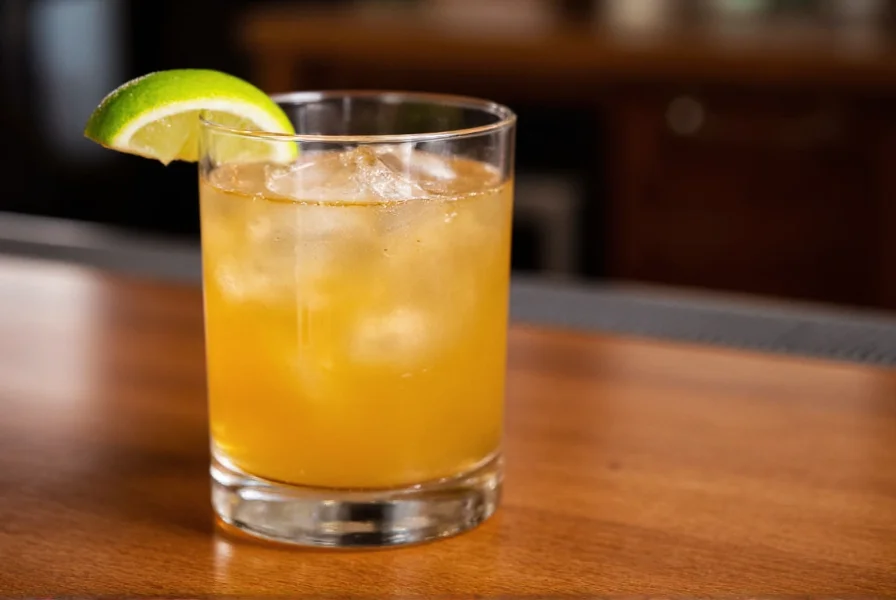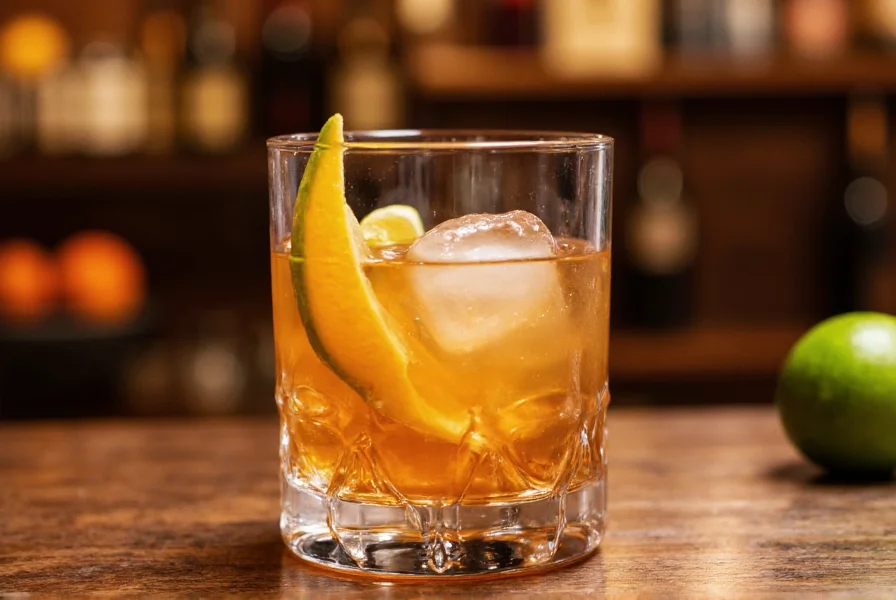When you mix bourbon and ginger ale, you're creating one of the simplest yet most satisfying highball cocktails. This combination has stood the test of time for good reason—the spicy warmth of bourbon complements the crisp, refreshing bite of ginger ale perfectly. Whether you're hosting a gathering or enjoying a quiet evening, these drinks offer approachable sophistication without complicated preparation.

The Essential Bourbon Ginger Recipe
The Bourbon Ginger represents the purest expression of this pairing. Unlike more complex cocktails, this drink shines through its simplicity. What makes it special isn't just the ingredients but how they interact—the bourbon's vanilla and oak notes soften while the ginger ale's carbonation lifts the spirit's complexity.
What You'll Need
| Ingredient | Measurement | Notes |
|---|---|---|
| Bourbon | 2 oz (60ml) | Middle-proof (90-100 proof) works best |
| Ginger ale | 4-6 oz (120-180ml) | Quality brand with real ginger |
| Fresh lime | 1/2 oz (15ml) | Essential for balance |
| Ice | Cubed | Large cubes melt slower |
Preparation Method
- Fill a highball glass with ice cubes
- Add bourbon and fresh lime juice
- Gently stir for 10 seconds to chill and integrate
- Top with ginger ale, leaving 1/2 inch at the top
- Give one gentle stir to combine (avoid over-stirring)
- Garnish with a lime wedge or wheel
Why This Combination Works So Well
Bourbon's inherent sweetness from corn mash and charred oak barrels creates a beautiful counterpoint to ginger ale's spicy-sweet profile. The carbonation in ginger ale lifts the bourbon's aromatics while softening its alcohol bite. This isn't just speculation—chemistry explains why these elements harmonize. The volatile compounds in bourbon become more apparent when combined with carbonated beverages, enhancing the drinking experience without requiring additional ingredients.
Variations That Elevate the Basic Recipe
Once you've mastered the classic preparation, these bourbon and ginger ale variations offer exciting ways to customize your drink while maintaining the essential character that makes this pairing special.
The Citrus-Forward Whiskey Buck
This variation builds on the basic formula by incorporating additional citrus elements. Add 1/2 oz fresh lemon juice to the standard recipe and consider using a ginger ale with more pronounced spice notes. The extra citrus creates a brighter profile that works particularly well during warmer months. Many professional bartenders recommend this as one of the best bourbon cocktails for beginners because it's forgiving yet distinctive.
Honey-Ginger Bourbon Fizz
For those who find traditional ginger ale too sweet, this adaptation uses 1/4 oz honey syrup (equal parts honey and hot water, cooled) added to the bourbon before topping with ginger ale. The honey enhances bourbon's natural sweetness while introducing floral notes that complement the ginger's spice. This represents one of the most popular bourbon ginger cocktail recipes among craft cocktail enthusiasts.
Ingredient Selection Matters More Than You Think
Not all bourbons and ginger ales create equally satisfying results. Understanding how different options affect your drink transforms a simple highball into something exceptional.
Choosing the Right Bourbon
For bourbon and ginger ale drinks, medium-proof bourbons (90-100 proof) generally perform best. Higher-proof expressions can overwhelm the ginger ale's delicate spice, while lower-proof options may get lost. Look for bourbons with pronounced vanilla and caramel notes rather than heavily oaked or smoky profiles. Some excellent middle-ground options include Buffalo Trace, Four Roses Yellow Label, and Wild Turkey 101. These represent ideal bourbons for ginger ale cocktails because they maintain character without dominating the mix.
Selecting Quality Ginger Ale
The difference between standard ginger ale and premium options dramatically impacts your drink. Most commercial ginger ales contain high fructose corn syrup and artificial flavors that create cloying sweetness without genuine ginger heat. For authentic bourbon ginger cocktails, choose brands using real ginger root and cane sugar like Fever-Tree, Q Mixers, or Bundaberg. These premium ginger ales provide the spicy kick that balances bourbon's sweetness, creating what many consider the perfect bourbon and ginger combination.
Common Mistakes to Avoid
Even simple cocktails can go wrong with small missteps. These pitfalls frequently undermine what should be a refreshing drink:
- Using flat ginger ale - Always use freshly opened ginger ale with vigorous carbonation
- Incorrect ice - Small ice cubes melt too quickly, diluting your drink
- Skipping the lime - The citrus element balances sweetness and enhances complexity
- Over-stirring after adding ginger ale - This releases too much carbonation
- Using low-quality bourbon - You'll taste every flaw in simple cocktails
Serving and Pairing Recommendations
Serve bourbon and ginger ale drinks in highball or Collins glasses rather than rocks glasses—the additional height accommodates the proper ginger ale ratio while maintaining ideal temperature. For garnishes, a lime wedge remains classic, but consider these sophisticated alternatives:
- Candied ginger for added sweetness and visual appeal
- A thin lemon twist expressing oils over the drink
- Fresh mint sprig for aromatic complexity
- Cucumber ribbon for a refreshing variation
These drinks pair exceptionally well with grilled foods, particularly anything with a sweet barbecue sauce. The ginger's spice cuts through rich flavors while bourbon's warmth complements smoky notes. They also work beautifully with spicy Asian cuisine—the ginger ale cools the palate while bourbon complements umami flavors.
Why This Drink Endures
The bourbon and ginger ale combination has maintained popularity for decades because it delivers maximum flavor with minimum effort. Unlike more complex cocktails requiring multiple ingredients and precise measurements, this highball offers consistent results with pantry staples. Its accessibility makes it perfect for both cocktail novices and experienced drinkers seeking a reliable, refreshing option. When prepared with quality ingredients and attention to detail, this simple drink exemplifies how less can truly be more in mixology.
Frequently Asked Questions
What's the difference between a Bourbon Ginger and a Kentucky Mule?
The Bourbon Ginger typically uses ginger ale, while a Kentucky Mule substitutes ginger beer for a spicier, less sweet profile. The Kentucky Mule often includes additional lime juice and is traditionally served in a copper mug, whereas the Bourbon Ginger works well in standard highball glasses with a simpler ingredient list.
Can I use ginger beer instead of ginger ale in bourbon cocktails?
Yes, substituting ginger beer creates a spicier, more robust drink often called a Kentucky Mule. Ginger beer has a stronger ginger flavor and less sweetness than ginger ale, which works particularly well with higher-proof bourbons. Many cocktail enthusiasts prefer this variation for its bolder profile, though it represents a different drinking experience than the classic bourbon and ginger ale combination.
What's the ideal bourbon to ginger ale ratio?
The standard ratio is 1:2 or 1:3 (bourbon to ginger ale), typically 2 oz bourbon to 4-6 oz ginger ale. However, personal preference plays a significant role—those preferring stronger drinks might use a 1:2 ratio, while those wanting a lighter cocktail might go up to 1:4. The addition of 1/2 oz fresh lime juice remains consistent across ratios as it provides essential balance to the sweetness.
Why does my bourbon and ginger ale drink taste flat?
This usually happens when using flat ginger ale or over-stirring after adding the ginger ale. Always use freshly opened ginger ale with vigorous carbonation, and limit stirring to just combining the ingredients—excessive stirring releases the carbonation too quickly. Serving immediately after preparation and using properly chilled ingredients also helps maintain the drink's effervescence throughout consumption.
Can I make a non-alcoholic version of this drink?
Yes, you can create a convincing mocktail version by replacing the bourbon with 2 oz of strong-brewed chai tea or a non-alcoholic spirit designed to mimic bourbon's flavor profile. Add the same amount of fresh lime juice and top with quality ginger ale. The chai tea version works particularly well as it contains complementary spices that echo bourbon's vanilla and oak notes without alcohol.











 浙公网安备
33010002000092号
浙公网安备
33010002000092号 浙B2-20120091-4
浙B2-20120091-4